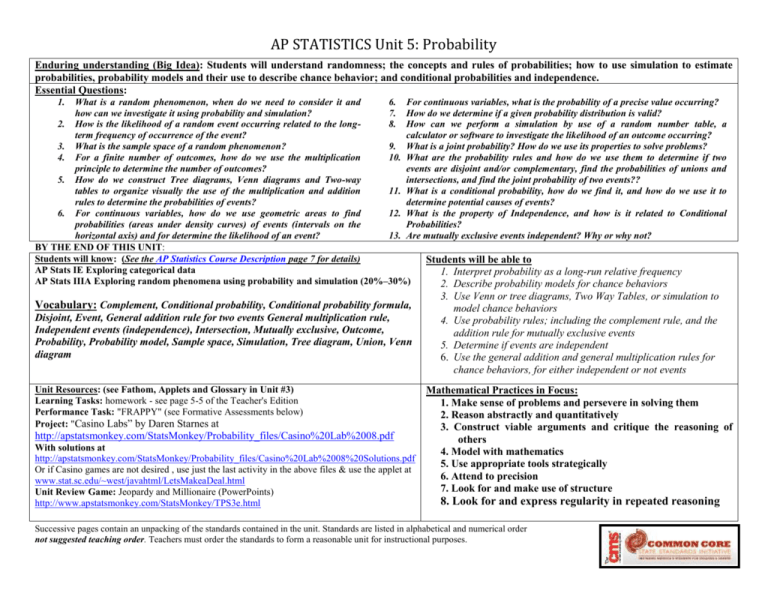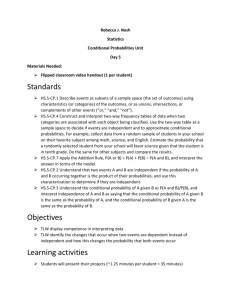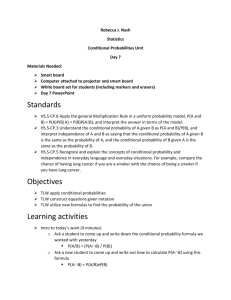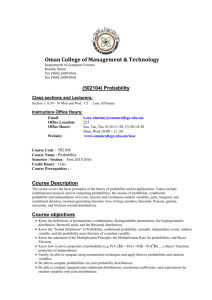AP Stat Unit 5 Probability
advertisement

AP STATISTICS Unit 5: Probability Enduring understanding (Big Idea): Students will understand randomness; the concepts and rules of probabilities; how to use simulation to estimate probabilities, probability models and their use to describe chance behavior; and conditional probabilities and independence. Essential Questions: 1. What is a random phenomenon, when do we need to consider it and 6. For continuous variables, what is the probability of a precise value occurring? how can we investigate it using probability and simulation? 7. How do we determine if a given probability distribution is valid? 2. How is the likelihood of a random event occurring related to the long8. How can we perform a simulation by use of a random number table, a term frequency of occurrence of the event? calculator or software to investigate the likelihood of an outcome occurring? 3. What is the sample space of a random phenomenon? 9. What is a joint probability? How do we use its properties to solve problems? 4. For a finite number of outcomes, how do we use the multiplication 10. What are the probability rules and how do we use them to determine if two principle to determine the number of outcomes? events are disjoint and/or complementary, find the probabilities of unions and 5. How do we construct Tree diagrams, Venn diagrams and Two-way intersections, and find the joint probability of two events?? tables to organize visually the use of the multiplication and addition 11. What is a conditional probability, how do we find it, and how do we use it to rules to determine the probabilities of events? determine potential causes of events? 6. For continuous variables, how do we use geometric areas to find 12. What is the property of Independence, and how is it related to Conditional probabilities (areas under density curves) of events (intervals on the Probabilities? horizontal axis) and for determine the likelihood of an event? 13. Are mutually exclusive events independent? Why or why not? BY THE END OF THIS UNIT: Students will know: (See the AP Statistics Course Description page 7 for details) Students will be able to AP Stats IE Exploring categorical data 1. Interpret probability as a long-run relative frequency AP Stats IIIA Exploring random phenomena using probability and simulation (20%–30%) 2. Describe probability models for chance behaviors Vocabulary: Complement, Conditional probability, Conditional probability formula, Disjoint, Event, General addition rule for two events General multiplication rule, Independent events (independence), Intersection, Mutually exclusive, Outcome, Probability, Probability model, Sample space, Simulation, Tree diagram, Union, Venn diagram Unit Resources: (see Fathom, Applets and Glossary in Unit #3) Learning Tasks: homework - see page 5-5 of the Teacher's Edition Performance Task: "FRAPPY" (see Formative Assessments below) Project: "Casino Labs” by Daren Starnes at http://apstatsmonkey.com/StatsMonkey/Probability_files/Casino%20Lab%2008.pdf With solutions at http://apstatsmonkey.com/StatsMonkey/Probability_files/Casino%20Lab%2008%20Solutions.pdf Or if Casino games are not desired , use just the last activity in the above files & use the applet at www.stat.sc.edu/~west/javahtml/LetsMakeaDeal.html Unit Review Game: Jeopardy and Millionaire (PowerPoints) http://www.apstatsmonkey.com/StatsMonkey/TPS3e.html 3. Use Venn or tree diagrams, Two Way Tables, or simulation to model chance behaviors 4. Use probability rules; including the complement rule, and the addition rule for mutually exclusive events 5. Determine if events are independent 6. Use the general addition and general multiplication rules for chance behaviors, for either independent or not events Mathematical Practices in Focus: 1. Make sense of problems and persevere in solving them 2. Reason abstractly and quantitatively 3. Construct viable arguments and critique the reasoning of others 4. Model with mathematics 5. Use appropriate tools strategically 6. Attend to precision 7. Look for and make use of structure 8. Look for and express regularity in repeated reasoning Successive pages contain an unpacking of the standards contained in the unit. Standards are listed in alphabetical and numerical order not suggested teaching order. Teachers must order the standards to form a reasonable unit for instructional purposes. AP STATISTICS Unit 5: Probability CORE CONTENT Cluster Title: B. Summarize, represent, and interpret data on two categorical and quantitative variables (S-ID) Standards: S.ID.5 Summarize categorical data for two categories in two-way frequency tables. Interpret relative frequencies in the context of the data (including joint, marginal, and conditional relative frequencies)… Cluster Title: D. Understand and evaluate random processes underlying statistical experiments (S-IC) S.IC.2 Decide if a specified model is consistent with results from a given data-generating process, e.g., using simulation Cluster Title: F. Understand independence and conditional probability and use them to interpret data (S-CP) S.CP.1 Describe events as subsets of a sample space (the set of outcomes) using characteristics (or categories) of the outcomes, or as unions, intersections, or complements of other events (“or,” “and,” “not”). S.CP.4 Construct and interpret two-way frequency tables of data when two categories are associated with each object being classified. Use the twoway table as a sample space to decide if events are independent … Cluster Title: G. Use the rules of probability to compute probabilities of compound events in a uniform probability model (S-CP) S.CP.7 Apply the Addition Rule, P(A or B) = P(A) + P(B) – P(A and B), and interpret the answer in terms of the model Cluster Title: I. Use probability to evaluate outcomes of decisions (S-MD) S.MD.6 (+) Use probabilities to make fair decisions (e.g., drawing by lots, using a random number generator) S.MD.7 (+) Analyze decisions and strategies using probability concepts (e.g., product testing, medical testing, pulling a hockey goalie at the end of a game) For Sections 5.1 & 5.2 NCSCOC 3.05 Apply concepts of probability to solve problems NCSCOC 3.07 http://www.dpi.state.nc.us/curriculum/mathematics/scos/2003/9-12/72apstatistics AP Stats IE2 Exploring categorical data … joint frequencies for two-way tables AP Stats IIIA1-3, 5 1 Interpreting probability, including long-run relative frequency interpretation; 2 “Law of Large Numbers” concept, 3 Addition rule…; 5 Simulation of random behavior and probability distributions Concepts and Skills to Master (on paper and with technology) Section 5.1 [Randomness, Probability and Simulation] The Idea of Probability Myths about randomness Simulations Section 5.2 [Probability Rules] Probability Models Basic rules of probability Two-way tables and probability Venn Diagrams and probability Successive pages contain an unpacking of the standards contained in the unit. Standards are listed in alphabetical and numerical order not suggested teaching order. Teachers must order the standards to form a reasonable unit for instructional purposes. AP STATISTICS Unit 5: Probability SUPPORTS FOR TEACHERS Critical Background Knowledge Prior material in this course contained in Units 1 – 4 (i.e. Chapters 1-4) Academic Vocabulary Complement, Disjoint, Event, General addition rule for two events, Intersection, Mutually exclusive, Outcome, Probability, Probability model, Sample space, Simulation, Union, Venn diagram Suggested Instructional Strategies Rely on the Teachers' Edition and the Platinum Resource Binder The text is excellent and students should have their book (and their calculator) at each class. The challenge is how to inspire kids to read and study it. There should be class discussions during each class using material from the book and using the calculator. Consider assigning the next class' material as a prereading. Especially focus on the boxes labeled "AP Exam Common Error" in the margins (and also in Appendix A) Begin with a discussion of the Case Study on page 281 and lay a foundation for power Do Activities on pages 284, 287 Do Activities on pages 215 and 220, followed by a technology simulation of the activity. Have a Class Discussion of the Rules for Simulation on page 289 and add rules to deal with repeats, out-of-range outcomes and stopping. Discuss the table on page 290 as examples of these rules (Very Important) Have a Class Discussion of Section 5.1's "Summary" on page 292 and Section 5.2's "Summary” on page 308 The College Board has posted tremendously helpful material http://apcentral.collegeboard.com/apc/public/courses/teachers_corner/2151.html in particular use: http://apcentral.collegeboard.com/apc/members/exam/exam_information/8357.html Useful directories for the released questions are at http://www.apstatsmonkey.com/StatsMonkey/AP_Review.html for FR look for AP Index 11_12.xls for MC look for MC_Index.xls - Daren Starnes Resources Textbook Correlation: Chapter 5 , Introduction and Section 1 (pages 280 - 298) Chapter 5, Section 2 (pages 299 - 311) Most of the PowerPoint slides on the Instructor's CD are very helpful. Use resources at http://apstatsmonkey.com/StatsMonkey/Statsmo nkey.html Monitor the AP Statistics List Serve [see Electronic Discussion Groups on http://apcentral.collegeboard.com/apc/public/co urses/teachers_corner/2151.html ] soon to be an AP community see https://epl.collegeboard.org/epl/login.do Successive pages contain an unpacking of the standards contained in the unit. Standards are listed in alphabetical and numerical order not suggested teaching order. Teachers must order the standards to form a reasonable unit for instructional purposes. AP STATISTICS Unit 5: Probability Sample Formative Assessment Tasks Skill-based tasks CHECK YOUR UNDERSTANDING (textbook pages 286, 292, 303, and 305) Use assessments at http://www.stats4stem.org/ Use Released Multiple Choice questions (see the last Suggested Instructional Strategy above for a link to the list of MC questions). The column "% correct” shows the global performance on the AP Exam for that question. Add a column to the spreadsheet to keep a record of the questions you used and when used. Problem Tasks At the End of Sections 5.1 and/or 5.2 students in collaborative student groups could determine solutions to relevant AP released Free response questions. Then provide each group with the model solution and have them update their solution if needed. Selected group should present their problem and updated solution to the class describing what they learned from their discussions For a list of free response questions that you could use. Go to http://www.apstatsmonkey.com/StatsMonkey/AP_Review.html Look for the link AP Index 11_12.xls. (Do not use 2003B #2 until the end of Chapter 5.) Add a column to the spreadsheet and keep a record of the questions you used and when used. Successive pages contain an unpacking of the standards contained in the unit. Standards are listed in alphabetical and numerical order not suggested teaching order. Teachers must order the standards to form a reasonable unit for instructional purposes. AP STATISTICS Unit 5: Probability CORE CONTENT Cluster Title: B. Summarize, represent, and interpret data on two categorical and quantitative variables (S-ID) Standards: S.ID.5 Summarize categorical data for two categories in two-way frequency tables. Interpret relative frequencies in the context of the data (including … conditional relative frequencies)… Cluster Title: F. Understand independence and conditional probability and use them to interpret data (S-CP) S.CP.2 Describe events as subsets of a sample space (the set of outcomes) using characteristics (or categories) of the outcomes, or as unions, intersections, or complements of other events (“or,” “and,” “not”). S.CP.3 Understand the conditional probability of A given B as P(A and B)/P(B), and interpret independence of A and B as saying that the conditional probability of A given B is the same as the probability of A, and the conditional probability of B given A is the same as the probability of B. S.CP.4 … Use the two-way table as a sample space to approximate conditional probabilities … S.CP.5 Recognize and explain the concepts of conditional probability and independence in everyday language and everyday situations Cluster Title: G. Use the rules of probability to compute probabilities of compound events in a uniform probability model (S-CP) S.CP.6 Apply the Addition Rule, P(A or B) = P(A) + P(B) – P(A and B), and interpret the answer in terms of the model S.CP.8 Apply the general Multiplication Rule in a uniform probability model, P(A and B) = P(A)P(B|A) = P(B)P(A|B), and interpret the answer in terms of the model. Cluster Title: I. Use probability to evaluate outcomes of decisions (S-MD) S.MD.7 (+) Analyze decisions and strategies using probability concepts (e.g., product testing, medical testing, pulling a hockey goalie at the end of a game) For Sections 5.3 NCSCOC 3.05 Apply concepts of probability to solve problems NCSCOC 3.07 Simulate sampling distributions http://www.dpi.state.nc.us/curriculum/mathematics/scos/2003/9-12/72apstatistics AP Stats IE Exploring categorical data 3. Conditional relative frequencies and association AP Stats IIIA 3 … multiplication rule, conditional probability and independence Concepts and Skills to Master (on paper and with technology) Section 5.3 [Conditional Probability ] Conditional Probability and Independence Independence: A special multiplication rule Tree diagrams and the general multiplication rule Calculating Conditional Probabilities SUPPORTS FOR TEACHERS Critical Background Knowledge Previous Skills and concepts in this course from Chapter 1 through Section 5.3 Academic Vocabulary Conditional probability, Conditional probability formula, General multiplication rule, Independent events (Independence), Tree diagram Successive pages contain an unpacking of the standards contained in the unit. Standards are listed in alphabetical and numerical order not suggested teaching order. Teachers must order the standards to form a reasonable unit for instructional purposes. AP STATISTICS Unit 5: Probability Suggested Instructional Strategies Sample Formative Assessment Tasks Skill-based tasks CHECK YOUR UNDERSTANDING (pages 314, 317, 321, and 323) Use assessments at http://www.stats4stem.org/ Use Released Multiple Choice questions (see the last Suggested Instructional Strategy above for a link to the list of MC questions) See suggestion for usage in Unit # 3 Use Quizzes at http://bcs.whfreeman.com/tps4e/#628644__630756__ Do the Chapter 5 AP Statistics Practice Test on page 336 Use ARTIST SCALE - Probability Resources Rely on the Teachers' Edition and the Platinum Resource Binder Textbook Correlation: The text is excellent and students should have their book (and their calculator) at each Chapter 5, Section 3 (pages 312- 337) class. The challenge is how to inspire kids to read and study it. There should be class Most of the PowerPoint slides on the Instructor's discussions during each class using material from the book and using the calculator. CD are very helpful. Consider assigning the next class' material as a prereading. Especially focus on the boxes Use resources at labeled "AP Exam Common Error" in the margins (and also in Appendix A) http://apstatsmonkey.com/StatsMonkey/Statsmonkey. Do Activity on page 206 (except just have cards with questions about basic statistics and html do an Observational Study of the # the student got correct, i.e. an Observational Study" Monitor the AP Statistics List Serve [see Electronic Do Activities on pages 215 and 220, followed by a technology simulation of the activity. Discussion Groups on Have a Class Discussion of the General Multiplication rule on page 319 and of the http://apcentral.collegeboard.com/apc/public/course Conditional Probability Formula on page 324. Have the class determine what the rules would be if the prior events were event B s/teachers_corner/2151.html ] soon to be an AP Have Class Discussions of Section 5.3's "Summary" on page 328 community see The College Board has posted tremendously helpful material (continued) https://epl.collegeboard.org/epl/login.do http://apcentral.collegeboard.com/apc/public/courses/teachers_corner/2151.html in particular use: http://apcentral.collegeboard.com/apc/members/exam/exam_information/8357.html Useful directories for the released questions are at http://www.apstatsmonkey.com/StatsMonkey/AP_Review.html for FR look for AP Index 11_12.xls for MC look for MC_Index.xls - Daren Starnes Problem Tasks At the End of Unit 5 do FRAPPY #6a [which uses 2003B #2]: http://apstatsmonkey.com/StatsMonkey/TPS3e_files/Frappy6a.pdf (Or as an alternate, see the last Suggested Instructional Strategy above for a list of free response questions that you could alternately use as your FRAPPY. Go to http://www.apstatsmonkey.com/StatsMonkey/AP_Review.html for the FR questions. Look for the link AP Index 11_12.xls. Add a column to the spreadsheet and keep a record of the questions you used and when used.) To Use Frappies: On the first page at Successive pages contain an unpacking of the standards contained in the unit. Standards are listed in alphabetical and numerical order not suggested teaching order. Teachers must order the standards to form a reasonable unit for instructional purposes. AP STATISTICS Unit 5: Probability http://ore.gen.umn.edu/artist/tests/index.html Use Released Multiple Choice questions (see the last Suggested Instructional Strategy above for a link to the list of MC questions). The column "% correct " shows the global performance on the AP Exam for that question. Add a column to the spreadsheet to keep a record of the questions you used and when used. http://apstatsmonkey.com/StatsMonkey/FRAPPYs.html click on the FRAPPY Presentation to learn about them and how to use them as Formative Assessments. (Click on the Frappy Presentation to Advance to a new slide. You may also download handout notes using the link to the right) Successive pages contain an unpacking of the standards contained in the unit. Standards are listed in alphabetical and numerical order not suggested teaching order. Teachers must order the standards to form a reasonable unit for instructional purposes.







